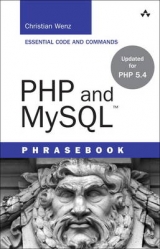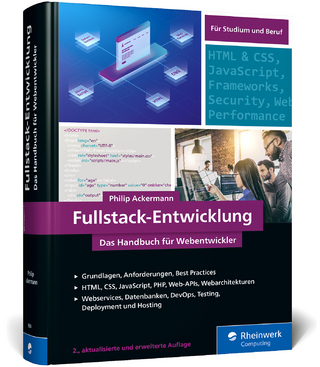
PHP Phrasebook
Addison-Wesley Educational Publishers Inc (Verlag)
978-0-672-32817-6 (ISBN)
- Titel erscheint in neuer Auflage
- Artikel merken
If you were traveling in Spain, but couldn't speak Spanish very well, you'd probably carry a Spanish dictionary with you. If you are a PHP developer who needs a portable reference guide for frequent use in your job, the PHP Phrasebook is perfect for you. The PHP Phrasebook is actually a pocket guide that is jam-packed with useful and essential PHP code "phrases" for the PHP developer's everyday use. The code is flexible, so it can be easily adapted to your needs and mulitple situations, and your time isn't wasted wading through chapters of tutorial lessons and extraneous information. The phrasebook covers PHP 5 and is relevant for PHP 4.
Christian Wenz is professional developer, trainer and consultant with a focus on web technologies. He frequently contributes articles to renowned IT magazines and speaks at conferences around the world. Christian is Germany's very first Zend Certified Professional and contributes to several PHP packages in the PEAR repository. Christian has written or contributed to several books on PHP and related technologies, including PHP 5 Unleashed.
Introduction
1. Manipulating Strings.
Comparing Strings
Checking Usernames and Passwords
Converting Strings into Hypertext Markup Language (HTML)
Using Line Breaks
Encrypting Strings
Checksumming Strings
Extracting Substrings
Protecting Email Addresses Using ASCII Codes
Scanning Formatted Strings
Getting Detailed Information About Variables
Searching in Strings
Using POSIX Regular Expressions
Using Perl-Compatible Regular Expressions
Finding Tags with Regular Expressions
Validating Mandatory Input
Validating Numbers (and Other Data Types)
Validating Email Addresses
Search and Replace
2. Working with Arrays.
Accessing All Elements of Numerical Arrays
Accessing All Elements of Associative Arrays
Accessing All Array Elements in Nested Arrays
Turning an Array into Variables
Converting Strings to Arrays
Converting Arrays to Strings
Sorting Arrays Alphabetically
Sorting Associative Arrays Alphabetically
Sorting Nested Arrays
Sorting Nested Associative Arrays
Sorting IP Addresses (as a Human Would)
Sorting Anything
Sorting with Foreign Languages
Applying an Effect to All Array Elements
Filtering Arrays
Getting Random Elements Out of Arrays
3. Date and Time.
Using Text Within date()
Automatically Localizing Dates
Manually Localizing Dates
Using the Current Date the U.S./U.K./European Way
Formatting a Specific Date
Validating a Date
Calculating a Relative Date
Creating a Sortable Time Stamp
Converting a String into a Date
Determining Sunrise and Sunset
Using Date and Time for Benchmarks
Using Form Fields for Date Selection
Create Self-updating Form Fields for Date Selection
Calculating the Difference Between Two Dates
Using GMT Date/Time Information
4. Interacting with Web Forms.
Sending Form Data Back to the Current Script
Reading Out Form Data
Coping with "Magic Quotes"
Checking Whether a Form Has Been Submitted
Saving Form Data into a Cookie
Prefilling Text Fields and Password Fields
Prefilling Multiline Text Fields
Preselecting Radio Buttons
Preselecting Check Boxes
Preselecting Selection Lists
Preselecting Multiple Selection Lists
Processing Graphical Submit Buttons
Checking Mandatory Fields
Checking Selection Lists
Writing All Form Data into a File
Sending All Form Data Via Email
Getting Information About File Uploads
Moving Uploaded Files to a Safe Location
5. Remembering Users (Cookies and Sessions).
Understanding Cookies
Creating a Cookie
Reading Out Cookies
Getting Rid of "Magic Quotes" in Cookies
Setting a (Reasonable) Expiry Date
Setting a Client-Specific Expiry Date
Deleting a Cookie
Making Cookies Accessible for Several Domains
Checking Whether the Client Supports Cookies
Saving Multiple Data in One Cookie
Saving the User's Language Preference
Understanding Sessions
Where to Store the Sessions
How to Maintain the Session State
Activating Sessions
Reading and Writing Sessions
Closing Sessions
Changing the Session ID
Creating Dynamic, Session-Aware Links
Implementing a Custom Session Management
Creating a Secured Area with Sessions
Creating a Secured Area Without Sessions
6. Using Files on the Server File System.
Opening and Closing Files
Reading from Files
Writing to Files
Locking Files
Using Relative Paths for File Access
Avoiding Security Traps with File Access
Working with CSV Data
Parsing INI Files
Retrieving File Information
Copying, Moving, and Deleting Files
Browsing the File System
Using PHP Streams
Using Bzip2 Archives
Returning Files with an HTTP Request
7. Making Data Dynamic.
Connecting to MySQL
Connecting to MySQLi
Sending SQL to MySQL
Prepared Statements with MySQL
Retrieving Results of a Query to MySQL
Connecting to SQLite
Sending SQL to SQLite
Retrieving Results of a Query to SQLite
Connecting to PostgreSQL
Sending SQL to PostgreSQL
Updating Data in PostgreSQL
Retrieving Results of a Query to PostgreSQL
Connecting to Oracle
Sending SQL to Oracle
Retrieving Results of a Query to Oracle
Connecting to MSSQL
Sending SQL to MSSQL
Retrieving Results of a Query to MSSQL
Connecting to Firebird
Sending SQL to Firebird
Retrieving Results of a Query to Firebird
Connecting Via PDO
Sending SQL Via PDO
Retrieving Results of a Query Via PDO
8. Using XML.
Parsing XML with SAX
Using DOM in PHP 4 to Read XML
Using DOM in PHP 5 to Read XML
Using DOM in PHP 4 to Write XML
Using DOM in PHP 5 to Write XML
Using SimpleXML
Transforming XML with XSL and PHP 4
Transforming XML with XSL and PHP 5
Validating XML
9. Communicating with Others.
Connecting with HTTP Servers
Connecting with FTP Servers
Checking Whether a Server Is Still Reacting
Creating a Web Service with PEAR::XML-RPC
Consuming a Web Service with PEAR::XML-RPC
Creating a Web Service with NuSOAP
Automatically Generating WSDL with NuSOAP
Consuming a Web Service with NuSOAP
Creating a Web Service with PEAR::SOAP
Automatically Generating WSDL with PEAR::SOAP
Consuming a Web Service with PEAR::SOAP
Creating a Web Service with PHP 5's SOAP Extension
Consuming a Web Service with PHP 5's SOAP Extension
Index.
| Erscheint lt. Verlag | 6.10.2005 |
|---|---|
| Verlagsort | New Jersey |
| Sprache | englisch |
| Maße | 177 x 116 mm |
| Gewicht | 245 g |
| Themenwelt | Mathematik / Informatik ► Informatik ► Programmiersprachen / -werkzeuge |
| Mathematik / Informatik ► Informatik ► Web / Internet | |
| ISBN-10 | 0-672-32817-8 / 0672328178 |
| ISBN-13 | 978-0-672-32817-6 / 9780672328176 |
| Zustand | Neuware |
| Haben Sie eine Frage zum Produkt? |
aus dem Bereich



